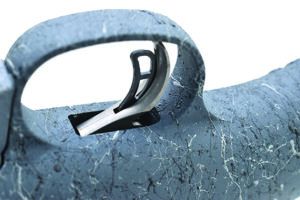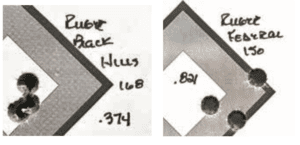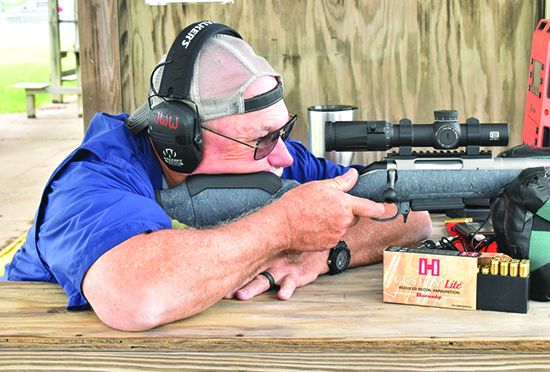Capable of taking most North American game at reasonable ranges and hitting steel or paper at more extended distances, the 308 Winchester is a favorite of bolt-gun shooters across the country, and we think that a good 308 Win. belongs in just about every well-equipped battery. We found a couple of new rifles chambered in 308 Win. that we wanted to shoot, the first of which is the latest offering from Weatherby, fresh from their new factory in Sheridan, Wyoming. The Model 307 Range XP, $1150, sports a 22-inch stainless-steel fluted barrel, muzzle brake, TriggerTech trigger, and a polymer stock with some very interesting features. The second sample is Ruger’s Second Generation American Rifle 46902, $620. We’ve reported on American Rifles several times in the past, consistently noting that they punch above their weight class. From what we see in the Gen 2’s redesigned stock and barrel, it looks like Ruger may have moved this rifle up to a heavier division.
At the range, we fired three different loads with three different bullet weights and, potentially, three different recoil levels. The first was a Hornady Custom Lite 125-grain SST reduced-recoil load, followed by a 150-grain PowerShok from Federal. Our heaviest load was Black Hills Ammunition’s 168 grain Open Tip Match. As usual, these cartridges came from Ammoseek.com, where the selection of available ammo is outstanding. Here’s how the rifles performed:
Ruger American Gen 2 No. 46902 308 Winchester
$620
Gun Tests grade: B
This new generation Ruger American sports an upgrade to its aesthetics, and accuracy was great, as we expected. There was an issue with the magazine that cost this new rifle a letter grade.

| Action Type | Bolt |
| Overall Length* | 41.25 in. |
| Barrel | 20 in. long, 1:10 in. twist |
| Overall Height** | 7.5 in. |
| Weight Unloaded | 6.25 lbs. |
| Weight Loaded*** | 6.6 lbs. |
| Sight Radius | NA |
| Action | Gun Metal Gray Cerakote-finished steel |
| Barrel | Gun Metal Gray Cerakote-finished steel |
| Magazine Capacity | 3 |
| Magazine Type | AICS-compatible Detachable Box |
| Stock | Polymer |
| Drop at Comb | + 0.25 in. |
| Drop at Heel | + 0.5 in. |
| Bedding | None |
| Buttplate | Soft rubber |
| Length of Pull**** | 12.0 in. or 13.75 in. |
| Receiver Scope-Base Pattern | Picatinny Rail |
| Trigger Pull Weight | 3.05 lbs. |
| Safety | 3-position tang |
| Warranty | None written |
| Telephone | (336) 949-5200 |
| Website | Ruger.com |
| Made In | U.S. |
* with compensator. ** with Picatinny rail, without rings. *** 3+1 168-grain rds. ****adjustable with spacers.
This team has worked with several Ruger American rifles and, overall, we’ve liked what we’ve seen. We most recently reviewed a specimen chambered in 243 Winchester in the March 2024 issue. That rifle earned an A- rating along with our Best Buy recommendation. Three-shot group sizes across three different types of ammo averaged 0.98 inch. Feeding was great, and everything worked fine.
So it was with interest that we ordered a second-generation version of the American Rifle. The price of this version is higher, so we needed to know what was different. Were there mechanical differences or just cosmetic?

The base action looked the same to us. This version has the diagonal flats on the top half and the same 0 MOA Picatinny rail. A cocking indicator still protrudes from the bottom of the bolt shroud. The Gen 2 model still has the Ruger Marksman Adjustable trigger, which broke right at 3 pounds on our 308. Also present was the expected full-diameter three-lug bolt. In the past, we’ve commented on Ruger American Rifles and their bolt throws on new guns being sticky. No worries here; the bolt on this new version ran as smooth as silk.
Now come the changes. Ruger is using a Gun Metal Gray Cerakote finish that matched up great with the Spider Web Gray stock. The 20-inch barrel is a heavier profile, measuring about 0.730 inch just behind the new radial muzzle brake. Threads, as expected on this caliber, were 5⁄8×24. Oh, and this new barrel is also fluted. The result was, hopefully, a stiffer, even more accurate barrel without incurring a weight penalty. In fact, our Gen 2 rifle (20-inch barrel with a muzzle brake) weighed almost exactly the same as a Gen 1 with its 22-inch barrel and no brake. Ruger also modified the tang safety to a three-position device instead of the original two-position switch. Now the shooter can operate the bolt with the gun on Safe.
The stock was substantially redesigned. The Gen 1 version had a lot of utility. The Gen 2 version has more life. The barrel is free-floated as we would hope. We mentioned the color — gray with black and light-gray webbing applied. Gripping surfaces still have raised projections on the fore end which, on this new model, are also textured, granting a more secure hold. The fore end is grooved, providing additional purchase for thumbs and fingertips. The rear of the stock now has a cheek piece that lifts the shooter’s head up, more properly in alignment for optics. With the rear of the comb higher than the front, it does a good job of pulling recoil away from the shooter’s jaw. Additional-height cheek pieces are available at Ruger.com. The piece on our sample was a little short, so we would avail ourselves of a taller insert.

Elsewhere, Ruger changed the recoil pad to a style that worked well for us. They also made the stock adjustable for length of pull. As it arrived, the Gen 2 rifle had a single insert that measured 1.75 inches thick, bringing total length of pull to 13.75 inches. That can be removed, bringing LOP down to 12.0 inches, and, once again, additional spacers allowing intermediate lengths are available at Ruger.com. There is a single sling swivel stud on the fore end and another inserted at an angle halfway down the buttstock.
The magazine arrangement gave us cause for concern. Ruger used the insert we’ve come to expect in which they can change the mag catch to make the same stock work with an AR-style mag, their proprietary mag, or an AICS-style mag. In this case, that left the magazine-release lever protruding below the trigger guard, where it seemed many things could catch the release and cause the magazine to drop inadvertently. The magazine included was a three-round, not-quite-flush piece that looked like an AICS pattern, but it had a problem, too. We could not seat the magazine with the bolt closed. Not even if the mag was empty. Not even with an enthusiastic rap (or three) on the bottom of the mag. Open the bolt and the mag could be seated just fine, but that would certainly make loading the rifle and then topping off the magazine problematic.
Because we just happened to have a ton of AICS-pattern mags laying around, we tried quite a few of them from different manufacturers. As a rule, the metal mags (Accurate Mag, MDT, ARC) worked fine, but all of the polymer mags refused to seat. We did note that the use of a 10-round metal AICS mag would cover the front of and obviate the concerns we had with the mag release. And when we tried to disassemble the action from the stock, we found the second action screw to be hidden underneath the mag release. Perhaps the issue was a total lack of coordination on the part of the testers that day, but we couldn’t seem to get the right angle on the screw, and we thought we would have to remove the mag catch to get to that screw. So, we left it alone. There were real and easy workarounds, but the irritation cost the Ruger a full letter markdown on its grade.
At the range, the Ruger Gen 2 American Rifle shot well, averaging about 0.9-inch groups across all three loads. The Hornady Lite ammo averaged the tightest three-shot groups at 0.88 inches. We were surprised when we measured the groups after looking at the chrono data. The standard deviation on the Hornady ammo at 72.3 fps was three to four times what the others showed. That much deviation normally precludes consistent shooting, but not in this case. The tightest group recorded was with the Black Hills 168-grain OTM at less than 0.4 inch. Once the magazine was in the rifle, everything fed well from the mag, but it didn’t like to feed singles.
Our Team Said: We liked what Ruger did with this new generation of American Rifle. When they sort out the problems with the magazine, this rifle should earn Ruger a solid A. As it is, it’s half the cost of the Weatherby, which will make it the choice for a lot of folks.
| 308 WINCHESTER RANGE DATA | ||
| Hornady Custom Lite 125-grain SST | Ruger American | Weatherby Model 307 |
| Average Velocity | 2578 fps | 2643 fps |
| Muzzle Energy | 1845 ft.-lbs. | 1939 ft.-lbs. |
| Best Group | 0.63 in. | 0.79 in. |
| Average Group | 0.88 in. | 1.27 in. |
| Federal PowerShok 150-grain JSP | Ruger American | Weatherby Model 307 |
| Average Velocity | 2700 fps | 2793 fps |
| Muzzle Energy | 2429 ft.-lbs. | 2599 ft.-lbs. |
| Best Group | 0.82 in. | 0.62 in. |
| Average Group | 0.99 in. | 0.83 in. |
| Black Hills 168-grain OTM | Ruger American | Weatherby Model 307 |
| Average Velocity | 2591 fps | 2614 fps |
| Muzzle Energy | 2505 ft.-lbs. | 2550 ft.-lbs. |
| Best Group | 0.37 in. | 0.86 in. |
| Average Group | 0.90 in. | 0.98 in. |
We conducted our tests at American Shooting Centers in Houston. At 100 yards, we fired multiple three-shot groups for accuracy from a well-sandbagged Caldwell TackDriver Pro rest from Brownells (100-027-023, $49), further supported by a large rear bag, heavy from Tab Gear (TabGear.com, $34).
Written and photographed by Joe Woolley, using evaluations from Gun Tests Team members. GT


























